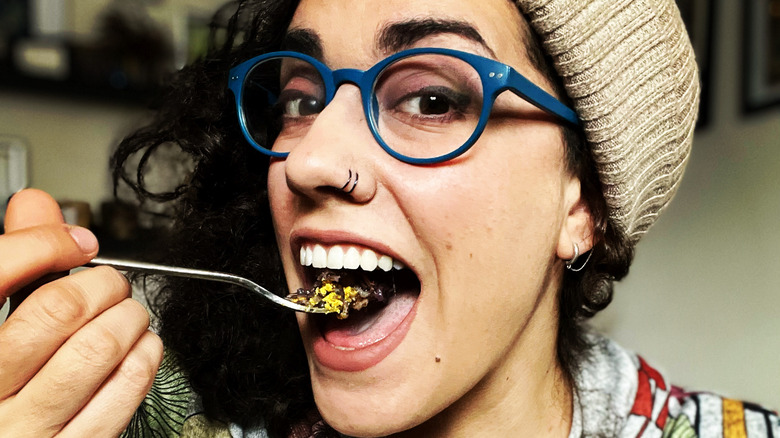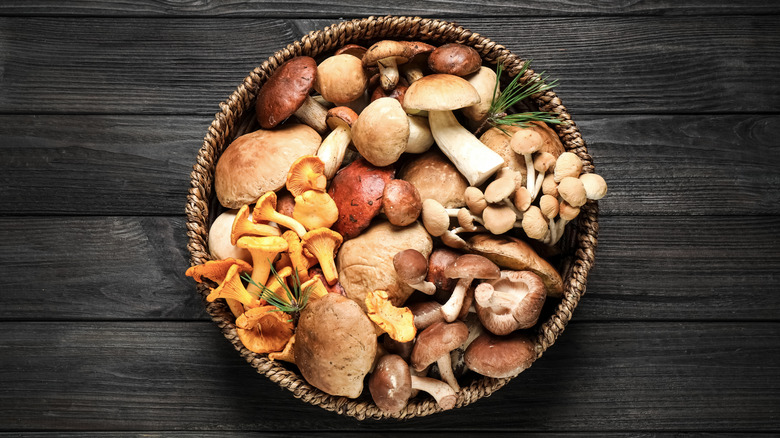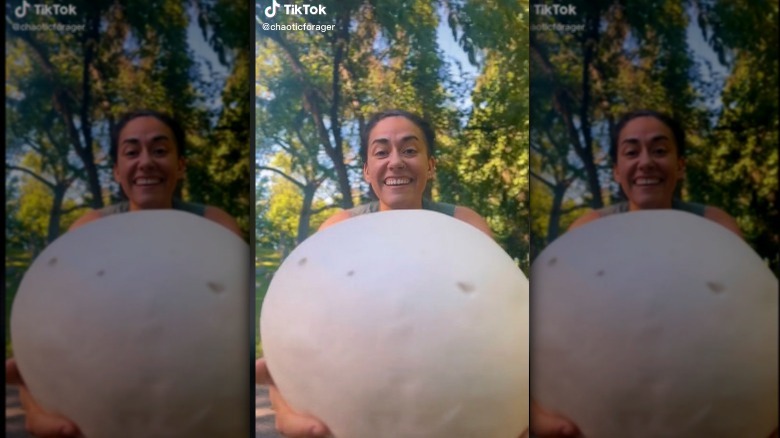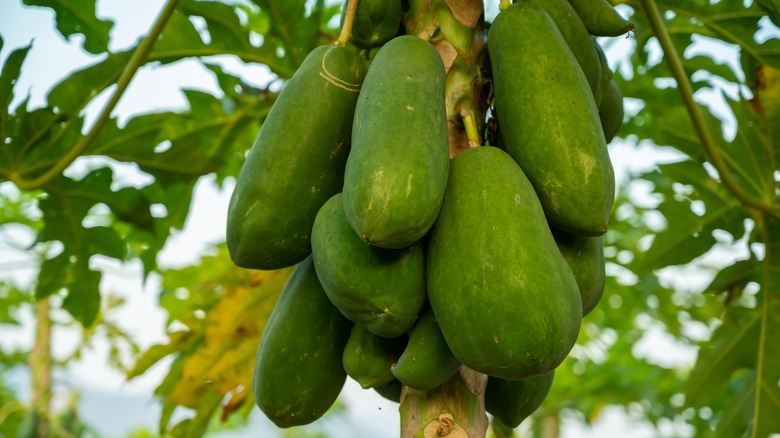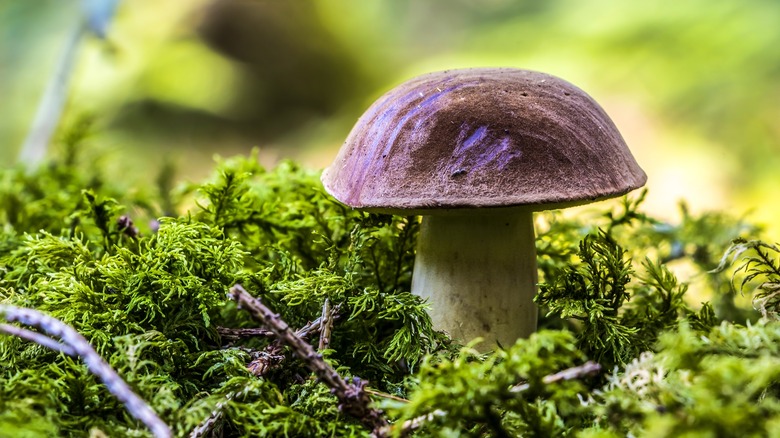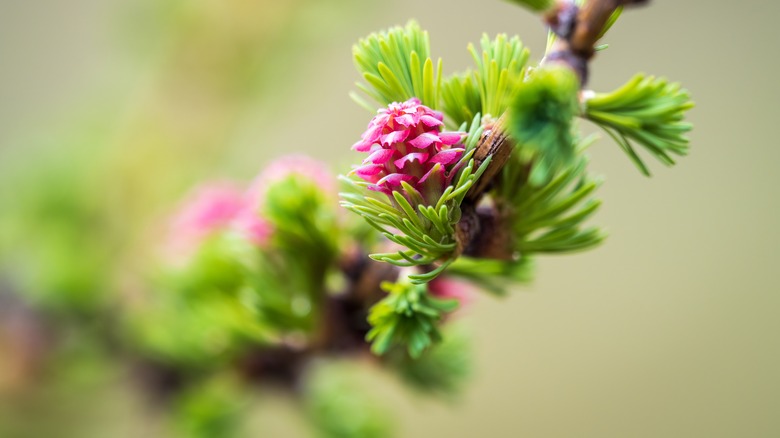TikToker Gabrielle Cerberville Digs Deep Into The Wild As A Latina Food Educator - Exclusive Interview
When you head to the grocery store on your weekly run, you probably aren't thinking too much about how your food made it onto the shelves. Recent food shortages aside, restaurants, delis, and markets always seem to have the vegetables and fruits that you need to meet your meal goals. Yet there are so many foods out there that we may not be aware of — such as puffball mushrooms or the pawpaw fruit. You can learn about both of them from Gabrielle Cerberville.
With about 968K followers and approximately 16 million likes to date, the TikToker has garnered an audience that is curious to learn about wild food. During an exclusive interview with Mashed, Cerberville described what it's like to be a wild food educator along with the honor of being a TikTok Latinx Creatives grant recipient. The forager posts her expertise on edible plants and fungi while creating recipes with foods she finds around her home. Who knew being creative in the kitchen could extend to your own backyard?
How Cerberville began posting wild food on TikTok
Could you tell me a little bit about how you started on TikTok?
Sure. I got started creating on TikTok when a lot of other millennials my age did, which was right towards the beginning of the pandemic when all of us were stuck at home [and] we were bored. We were trying to entertain ourselves and connect with people, missing that human interaction. I had also happened to choose to move right at the same time. I moved to a new city, and I lost all my foraging spots. I had to go find new ones and decided, well, maybe this is a good opportunity to make some videos at the same time and keep some connections with some old friends [and] make some new friends.
Congratulations on being named a TikTok Latinx Creatives grant recipient. What does being a recipient mean to you?
To be awarded this grant, it's such an honor. It means so much more than I can say, because most of my life, I've felt that I'm not Latin enough to be Latina and I'm not white enough to be white. I never quite feel like I belong in one world or the other. Being honored with this grant and being accepted in this community gives me this overwhelming sense of belonging.
That's wonderful. I was looking through your page and found it particularly interesting. How did you go about becoming a wild food educator?
I started by engaging with wild food, which was already a weirdo thing to do. I've been foraging since I was about 5 years old. I got into mushrooms when I was about 25, so about five, six years ago. I've always been a little bit of an insufferable know-it-all, and I like entertaining people, so it all fell into place. Doing wild food education made perfect sense for me.
Why Cerberville uses puffball mushrooms in recipes
What is the most exotic plant or food you've ever found or used in a recipe?
There are a lot of things that I eat that a lot of people haven't tried. [It's] probably some mushrooms that I cook and eat. A lot of people get excited about puffball mushrooms ... They look really weird. They have a texture a little bit like tofu, but better — no offense to tofu. That certainly looks exotic.
A lot of the large polypores that I eat, like chicken-of-the-woods or hen-of-the-woods, are pretty different for most people. They're not something that a lot of people eat. But when we think about food being exotic, the things that I'm eating are ultimately the opposite of exotic. They're local; they're so much just what we encounter in the environment directly around us. A lot of the things that we've gotten used to eating are actually the exotic foods.
I saw one of your viral videos was the puffball pizza. How did you come up with that recipe? What was your thought process behind that?
The recipe isn't entirely original. I've seen a lot of recipes for puffball pizzas. The way that I do it is a method that I've come up with more or less myself. There are a lot of people that repeat each other in the foraging community because we're dealing with very niche ingredients. But you can tell a seasoned forger by the fact that they know what to do with those ingredients.
I learned over time while working with this mushroom that you had to press it flat, you had to dry-fry it first, then you had to bake it. A lot of those recipes that I read will leave out big parts of that, and the result doesn't taste as much like a pizza.
Cerberville reveals the most underrated wild foods
Are there any wild foods that you've tried that you disliked?
There's one that's really popular. It's the idea of making flour out of this plant called Rumex or dock. It produces these little brown seeds. The idea is that you grind them into the flour, and you can use that flour in baking — and I don't like the texture of the flour. But very often, if I don't like something, I try to blame my methods of preparing it rather than the food itself, because there's probably a better way to do it that I would appreciate more.
That's a good outlook. Is there a food or ingredient that you found that you think is totally underrated?
Oh my God — there are so many. One that's common in the Midwest is spicebush. It's this beautiful shrub. It has these little green berries that turn red, and you can use those berries like allspice, or I think they taste like cardamom. They are so tasty. You can use every part of that plant. You can use the twigs, you can use the leaves, and it's such a beautiful flavor. I've made masala chai with it. I use it basically anywhere that I would use allspice, and it's so delicious and it's everywhere. It's all over the place.
Another one would be pawpaws.
Can you explain what pawpaws are?
Pawpaws are the largest fruit that's native to North America. They're about that big or so. They look like mangoes, but they taste like a banana and a mango had a delicious custard baby. That's one of my favorites that I forage. They're pretty abundant, but they go bad quickly, so most people haven't tried one.
How Cerberville knows what mushrooms are safe for consumption
You nickname yourself as "Mushroom Auntie" online. Could you give me an overview on how you can identify what mushrooms from the woods are safe to eat?
The thing about mushrooms is that you have to take them on a case-by-case basis. Mushrooms are like people that way. You can't tell a good one or a bad one just by looking at it — you have to get to know it. There are some mushrooms that are easy to identify and other mushrooms that are harder to identify, but there are a few that are pretty easy to get started with, some things like chicken-of-the-woods or puff balls or morel mushrooms. Those are the ones that usually get people hooked when they're starting to look for mushrooms.
What is the most frequent question about food from the forest that you get asked by your followers?
"How do you know an animal hasn't peed on that?"
That's funny. Well, that makes sense — you don't know that, I guess.
I usually ask, "Do you wash your food at home?" Because you should. Your food is also grown outside.
There you go. What is the most outlandish recipe that you've ever posted on your page?
Oh, man. I'm going to have to think back through some recipes.
I know you posted a lot, so it's hard to choose.
Yeah. This is a tricky one, and I don't feel like I posted anything too outlandish this year.
What Cerberville wants you to know about wild food
Is there anything you would like people to know about our environment and wild food in general?
The important thing for me to point out is that this used to be common knowledge. It used to be something that everybody knew at least a little bit about. We would be able to go out and collect certain things without worrying too much about what they were. We knew those things. Foraging is one way that we can reclaim our agency when it comes to what we eat. It's a way that we can reduce the carbon emissions that are associated with what we eat.
Collecting wild food from places near you infuses those locations with value, so we are more likely to want to protect them because they provide us with food. Overall, incorporating even just a little bit of foraging in your diet makes you more aware, makes you more mindful, and is really healthy for you. A lot of the food that grows in the neighborhood around you is more nutritionally dense than what you can get at the grocery store.
It's great that you're educating people through your page, and it seems people take a strong interest in it, so that's awesome. What is one ingredient that you could never live without?
At this point, probably mugolio. This might be up there with my most outlandish recipe, although it's not something that's super uncommon. It comes from an Italian recipe. You take unripe pine cone buds — the little green ones — and you cover them with sugar. You let it sit for several months, usually five or six months.
Then you have this beautiful, rich, sticky, thick syrup that's like resinous molasses, and it's so good. I put it on everything. You can use it when you're cooking meat. It's really good whisked up with soy sauce and spread on tofu. I use it in a lot of my mushroom dishes. You can make barbecue sauce with it. At this point, I eat so much of it all the time that I don't think I could live without it.
Five to six months. That's a commitment.
It is. But if you're ADHD, then you can forget that it exists for five or six months, and it'll still be fine. It's not like it can go bad in the back of your cabinet.
Cerberville names the one chef she'd want to cook her dinner
Who is the one chef you'd want to cook you dinner?
René Redzepi. He's the head chef and owner-founder of a restaurant called Noma in Copenhagen, and that restaurant has been named best in the world a few times. I really like his approach to food. He uses a lot of foraged ingredients, a lot of wild food, and he does a lot of fermentation, which is really interesting. I would love to have a meal cooked by René.
Is there a certain dish that he uses that you take inspiration from at all? Or what does he normally do?
He does a lot of things. To be fair, it's a whole team that he's in charge of, but they do some beautiful things with kombucha SCOBYs. He makes kombucha SCOBY steaks, and I'm very interested in that. It sounds weird, and I like weird things, so I have to try. He did a pop-up in Mexico a couple of years ago, and he's into using food that's from the area. He was doing some interesting things with Mexican chefs, and I would love to see what he makes and try it.
Head to TikTok's press release to learn more about the Latinx Creatives Grant recipients or check out Gabrielle Cerberville TikTok page to keep up with her latest videos.
This interview was edited for clarity.
